| The Vertical Shaft Brick Kiln : a technology for the masses Dr Soumen Maity smaity@devalt.org
In spite of various appropriate and alternative technologies based on local and sustainable resources, propagated for providing low-cost housing to the millions, the conventional burnt clay brick still holds sway as the principal walling material and will be amongst the most commonly used building materials for quite some time. Unsustainable Technology The conventional technologies for firing clay bricks in the country, such as intermittent in clamps and Bull’s Trench Kilns, consume large quantities of energy. The net contribution of burnt bricks towards energy consumption plays a significant role in the Indian economy as it presently accounts for 27% of the total national energy consumption in production of construction materials. Even a small reduction in specific consumption of fuel per kilogramme of brick will have a significant impact on the energy scenario of the country. Besides the consideration of energy consumption, the negative impact of the brick industry on the environment is of great relevance. Accelerators for change In 1992, the Ministry of Environment and Forests finally decided to prevent pollution at the source and encourage, develop and apply the best available technological solutions. In response to a public interest litigation, Supreme Thus, the time was ripe for introduction of energy efficient technologies to affect energy savings and demonstrate lower levels of emissions in order to meet new environmental standards. VSBK- The Chinese Experience VSBK (Vertical shaft brick kiln) has a long history of evolution. The technology was first born in China. It is not known when the technology was seeded, but statistics reveal that this technology came into being between 1968 and 1973. During the decade, in response to the high demand of building materials due to A few years later, in 1985, the Chinese Government decided to improve the efficiency of the existing kilns. Commissioned by the Government, the Energy Research Institute of the Henan Academy of Science, in Zengzhou, Henan Province, initiated a study to improve the existing VSBKs. The final result of the accelerated efficiency project was above all the promotion of the wider and much longer shaft with a permanent, stable structure. Beginnings in Nepal In 1990, The Ceramics Promotion Project (financed under GTZ-GATE project) tested the viability of the Chinese VSBK technology in Kathmandu, Nepal. A twin shaft kiln was constructed at Kathmandu Brick Factory, Lubhu, Nepal. The shafts were 1 x 1 metre in cross section and six metres in height. The essential difference between this and the Chinese kiln was the absence of a ramp for transportation of green bricks to the loading platform. Instead, a mechanical hoist was deployed for the above. Having an energy consumption of around 1MJ per kg of fired brick, the energy saving potential of the technology was clearly demonstrated. However, both kilns ran into early technical problems that the entrepreneurs could not solve unaided. The lack of access to reliable technical backstopping was responsible for early failure of this technology. Enthusiastic welcome in Bangladesh With assistance from SDC, a brick kiln owner from Conforce Ltd, Dhaka, Bangladesh visited one of the VSBK units in Kathmandu, Nepal. Inspired by what he witnessed, the entrepreneur subsequently built a kiln in 1993. The height of the kiln was double that of the standard version used in China. The structure of the kiln was made with solid blocks without a thick layer of insulation between the inner kiln wall and the outer supporting structure. Untrained firing crew and excessive draught, coupled with high energy consumption (1.5 MJ per kg of fired bricks) and poor quality, led to its demotivation. The need for the same specialized assistance was overlooked once again. The pilot plant in Bangladesh was never actually stabilized and was finally dismantled. The attempt to transfer the technical know-how to Bangladesh was a spontaneous, private initiative. The entrepreneur did not know the finer aspects of the technology. Without requisite technical backup support, he made fundamental mistakes in the design and construction of the kiln. Production Capacity : A Hurdle in Pakistan In 1992, under GTZ-GATE, a pilot project was undertaken to test the suitability of VSBK in Peshawar, Pakistan. The arrival of a three member team from Henan University of China and one Ceramic Expert from Denmark spelt the dawn of the VSBK era in Pakistan. A two shaft kiln (each shaft measuring 1 m x 1 m) was constructed in Badaber, Peshawar. The production capacity was around 3722 bricks per 24 hours. After its initial success, several units were established in Jalala, Mardan district, Hayatabad, Peshawar and nearby places. The VSBK demonstration (two shaft) units were marketed as an alternative to the Bull’s Trench Kiln (BTK) technology. The typical production of a BTK varied between 15,000 to 50,000 bricks per day in Pakistan. With only two shafts, the VSBK demonstration units could not produce more than 3,700 bricks per day. Thus, there was a clear imbalance between the output capacity of the VSBK and expectations of the entrepreneurs. This difference proved to be a major stumbling block in attracting BTK owners towards the VSBK technology. Inappropriate information on the limits and potentials of the VSBK technology resulted in a misjudgment, which limited its marketability. As a consequence of this oversight, the VSBK technology made no significant breakthrough in Pakistan beyond the early pilot project successes. Alternative fuels in Sudan A VSBK was adapted for use in Sudan. During 1996, a pilot kiln was constructed by the Building and Road Research Institute (BRRI) of the University of Khartoum in cooperation with GTZ-GATE. The fuel used was carbonized agricultural waste from cotton stalks, sunflower stalks or bagasse. The carbonized fuel, reduced to a granular size, was dispersed between the interspatial gaps amongst the green bricks during the loading of the shaft from the top. This VSBK was the first of its kind that used carbonized agricultural waste. No recent updates on the operations of this technology are available. Enthusiastic adoption of VSBK in India VSBK in India was launched in 1995 by Swiss Agency for Development and Cooperation (SDC) as a project on introducing sustainable production systems for construction materials, including kilns for burnt bricks. The main objectives of the project were to assess the potential, demand, economic viability, energy efficiency and ecofriendliness of VSBK in the Indian context. The success of any technology transfer process depends to a large extent on the capacity of the recipient to absorb the technology. In the Indian SME sector, it was difficult to find a single enterprise or institution having the capacity to absorb, adapt and diffuse a complex technology such as VSBK. From the very beginning, it was moulded into a multiple partner activity. Development Alternatives, a leading independent sector organization, working in the area of technology based livelihoods, was appointed as the implementing agency. The Energy and Resources Institute was the partner focussing on energy and environment performance aspects. SKAT and Soranne – two Swiss consulting organizations-were assigned advisory and backstopping responsibilities of the project. Chinese and Danish experts shared their international experience in the transfer of VSBK technology. From the lessons learnt during the international survey, a long term association with the Chinese team was established. The Chinese experts and the highly competent Chinese craftsmen worked hand in hand with the masons and engineers during the construction. It was interesting to observe many technical "exchanges" between the Chinese workmen who knew only Chinese and the Indian craftsmen who knew only Hindi. This reinforced the belief that technology transcends the confines of language and is universal in its nature. Based on the documented experiences from neighbouring countries, it was decided at the outset to promote VSBK as a small capacity, flexible technology. The VSBK production units delivering 10,000 bricks per day, could never be a substitute to the large scale fixed chimney BTKs producing between 30,000 to 50,000 bricks per day. Thus, the demonstration VSBK units were constructed in areas where proliferations of clamps or small scale movable chimney units producing 10,000 – 20,000 bricks per day were documented. India is a large country and considerable regional variations are observed across the brick industry in terms of raw materials' quality, climatic conditions, technology selection, working habits, socio-economic conditions of consumers, entrepreneurs, workers and final product quality. To test the adaptability of VSBK to these regional variations, it was decided to pilot test the technology at four different locations with four different institutions in the Northern, Eastern, Southern and Western zones. Multiple anchors of the technology were put into place primarily to -
Thus in India, the first two pilot kilns were established with NGOs. SDC provided the financial support for construction and operation of these two kilns and the project retained substantial control over the management of these kilns. The initial testing and anchoring was thus done under a closely controlled environment. Once the technical viability and energy conservation potential of the technology was demonstrated the next two pilot kilns were established with private entrepreneurs. The continuous adaptation of the VSBK technology to local requirements was assessed as a key to its success during the learning mission in neighbouring countries. Apart from ensuring the know-how transfer, in long term provision was also made for involving national and international ceramic, energy and environment experts to help regional partners in the continuous adaptation of the technology. The provision for further research effort in the form of an established "VSBK Research and Development Centre" in Datia, Central India was ensured to cater to the evolving needs of the brick industry. Commercial Success is Achieved Thus, the stepping stone of commercial dissemination was established. Within a span of three years (2000 – 2003), more than 30 VSBKs were established in a commercial mode. The qualities of bricks were accepted in the market at a premium. Most of the entrepreneurs were fully satisfied with the flexibility and performance of the kiln. This was Brick producers from other areas also cloned the technology, proving its acceptance in the brick industry. Till date, more than 80 VSBK units have been established or are under varied stages of commissioning all over the country with active dissemination support from various partners like Development Alternatives, Gram Vikas, The Energy and Resources Institute, Damle Clay Structurals, commercial promoting agencies like Technology and Action for Rural Advancement and leading Government policy stakeholders like Central Pollution Control Board and Building Materials and Technology Promotion Council. To achieve large scale and positive environmental impact, focused support has been a felt need for dissemination of this improved brick technology in new brick clusters affected by environmental regulation. The new states of Chattisgarh and Jharkhand are experiencing spurt in demand for clay bricks and both have a dominant presence of movable chimney kilns, presently threatened with closure. New initiatives has to respond to the needs of the entrepreneurs by substantially lowering the risks in the brick business. The lowering of risks is likely to be achieved with robust technology, through extension of the brick making season, achieving critical presence of the new technology and improving brick quality within existing brick clusters. The "Greening of Brick Industry" project is a joint initiative between Development Alternatives, Technology and Action for Rural Advancement launched in May 2004 with support from the Indo Canada Environment Facility. It has been conceived with an aim to employ an overarching strategy of "Capacity Building" to facilitate a collaborative balanced relationship between different stakeholder interests to work actively towards improving the environmental and social conditions in the brick sector. The main components of this strategy are: Facilitating enhanced participation to enable informed decision making This strategy component directly links brick community interests with the environmental and their social well-being. The stakeholder network involving brick associations, regulatory agencies, and policy makers will be enabled to exercise positive influence in changing entrepreneur behaviour to conform to emerging environmental legislation. In contrast to threats of closure, the entrepreneur will be confronted with technological and business solutions that will be customized to the market and livelihood needs of the brick worker community, and respond to tightening environmental norms. Intensive capacity building to leverage market competencies This strategy component will be directed towards strengthening supply of skilled manpower in the brick sector and business interests of market based service providers. This strategy integrates business interests with environmental well-being. The network of business development associates, equipment and service suppliers will be strengthened in promoting environmentally sound technology solutions. Spin-off resurrection in Nepal After the initial success of VSBK technology in India as a viable alternative to traditional brick making, with a huge potential in energy efficiency and environmental performance, SDC deemed it fit to relook at the dissemination of VSBK technology in Nepal as a "Technology Transfer Programme". The programme is being implemented by Skat-Consulting, Switzerland in association with Development Alternatives, Encouraged by the positive results, HMG, Nepal has recently banned the operation of movable chimney BTK and has also initial legal and administrative action to convert the existing polluting brick kilns into energy efficient and less polluting technologies. A high level of awareness on economics of VSBK business has also been created amongst the brick practitioners. Overwhelming dissemination in Vietnam In Vietnam, brick sector is traditionally a small and family based industry and common in rural areas. It is one of the largest industries which generate much employment and income. Based on ownership, the small and medium family based enterprises cater to about 70% of the annual brick consumption. SDC, in cooperation with Entec AG, introduced VSBK in Nam Dinh Province during 2003 to identify and develop economically viable and environmentally sound solutions for the needed improvements in the brick sector. The pilot kiln was constructed with active support from Chinese experts. Measure of acceptance of the technology is demonstrated by proliferation of more than 100 units within a short span of one year. However, the benefits reaped in the Indian experience are clearly not being demonstrated in a majority of the kilns due to lack of specific technological support. Under the UNDP – SGP a pilot scale VSBK will be introduced in Xuan Quang, a commune in Van Giang district, Hung Yen Province to demonstrate new technologies in energy conservation. The project will focus on technology transfer and awareness raising on environmental protection and sustainable use for brick makers. Thus, VSBK has come a long way as a people-friendly technology which has proved that `small is posssible'. It is also clear that, the success of this technology can only be ensured through effective know-how transer, technical support and engagement of government on key policy issues. q | ||||
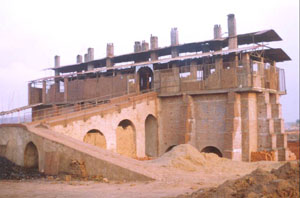 beings. In India, with the rapid growth in population and infrastructure building, it is increasingly becoming difficult to balance between the demand and supply of construction materials.
beings. In India, with the rapid growth in population and infrastructure building, it is increasingly becoming difficult to balance between the demand and supply of construction materials.  Court of India passed an order giving deadlines to the Government of India to act on the matter. The Government at last issued a notification in 1996 to close down all movable Bull’s Trench Kilns or convert them to fixed chimney kilns. Permission was also granted to find alternative technologies with lower emissions. Although this order was complied with to a certain extent in most of the States, movable chimney kilns are operating in some areas even today. This is due to lack of strict enforcement and availability of appropriate alternatives in lieu of the fixed chimney kilns for small to medium entrepreneurs.
Court of India passed an order giving deadlines to the Government of India to act on the matter. The Government at last issued a notification in 1996 to close down all movable Bull’s Trench Kilns or convert them to fixed chimney kilns. Permission was also granted to find alternative technologies with lower emissions. Although this order was complied with to a certain extent in most of the States, movable chimney kilns are operating in some areas even today. This is due to lack of strict enforcement and availability of appropriate alternatives in lieu of the fixed chimney kilns for small to medium entrepreneurs.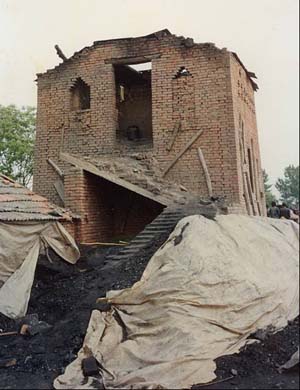 the "Green Revolution" in China, this type of kiln was mainly practiced as a small family based enterprise by farmers. Since this type of kiln required very little land, most of the farmers with individual land holdings took it up as an alternate means of income. During this time, it was mainly used for small scale brick production only ranging between 2500 to 5000 bricks per day.
the "Green Revolution" in China, this type of kiln was mainly practiced as a small family based enterprise by farmers. Since this type of kiln required very little land, most of the farmers with individual land holdings took it up as an alternate means of income. During this time, it was mainly used for small scale brick production only ranging between 2500 to 5000 bricks per day. 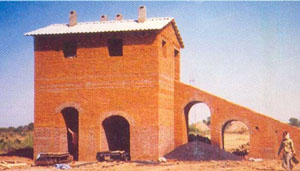 Capacity building of the local team was facilitated by regular information exchange amongst team members through meetings, workshops and continuous exchange of experiences. Systematic interaction with national and international experts in the areas of ceramics engineering, brick production, kiln technology and techno commercial evaluation was organized. Indigenous capacities were built up to design, construct and operate new kilns in a commercial mode.
Capacity building of the local team was facilitated by regular information exchange amongst team members through meetings, workshops and continuous exchange of experiences. Systematic interaction with national and international experts in the areas of ceramics engineering, brick production, kiln technology and techno commercial evaluation was organized. Indigenous capacities were built up to design, construct and operate new kilns in a commercial mode.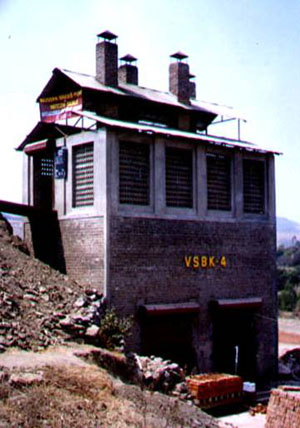 reiterated by the increased investment in selective mechanization and capacity augmentation. The unique selling proposition of the VSBK during this phase was its energy efficiency. The operation of pilot VSBK kilns has demonstrated energy savings of at least 30 to 40 percent in comparison to the best existing kilns. Further, the air pollution is reduced by at least a factor of 5 using VSBK technology. The watchdog of environmental pollution in India, Central Pollution Control Board has also approved this technology certifying it as one of the cleanest brick production systems even compared to the fixed chimney VSBK. The VSBK technology has been specifically adopted to suit a scale of production between 15 to 35 lakhs of bricks annually. Enhanced profitability has also been demonstrated through production months ahead of traditional kilns and even in monsoon season. The VSBK entrepreneurs are at ease with the technology as the firing process takes only 24 to 30 hours, and management of product quality is easier.
reiterated by the increased investment in selective mechanization and capacity augmentation. The unique selling proposition of the VSBK during this phase was its energy efficiency. The operation of pilot VSBK kilns has demonstrated energy savings of at least 30 to 40 percent in comparison to the best existing kilns. Further, the air pollution is reduced by at least a factor of 5 using VSBK technology. The watchdog of environmental pollution in India, Central Pollution Control Board has also approved this technology certifying it as one of the cleanest brick production systems even compared to the fixed chimney VSBK. The VSBK technology has been specifically adopted to suit a scale of production between 15 to 35 lakhs of bricks annually. Enhanced profitability has also been demonstrated through production months ahead of traditional kilns and even in monsoon season. The VSBK entrepreneurs are at ease with the technology as the firing process takes only 24 to 30 hours, and management of product quality is easier.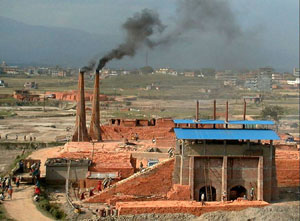 India and supported by His Majesty's Government, Department of Cottage and Small Industries. Under this technical support programme, two pilot kilns were constructed by 2004 and the programme is being successfully implemented since May 2003 in Imadole, Lalitpur district within the Kathmandu Valley. The two pilot kilns were established on a commercial basis to optimize construction and operational practice of VSBK and to implement a large component of social action with the brick workers. The initial operation achieved a 30% reduction in energy consumption and around 80% reduction in emission parameters. The overall mass emission loads are also significantly lower than that of the presently operating movable or fixed chimney BTK.
India and supported by His Majesty's Government, Department of Cottage and Small Industries. Under this technical support programme, two pilot kilns were constructed by 2004 and the programme is being successfully implemented since May 2003 in Imadole, Lalitpur district within the Kathmandu Valley. The two pilot kilns were established on a commercial basis to optimize construction and operational practice of VSBK and to implement a large component of social action with the brick workers. The initial operation achieved a 30% reduction in energy consumption and around 80% reduction in emission parameters. The overall mass emission loads are also significantly lower than that of the presently operating movable or fixed chimney BTK.